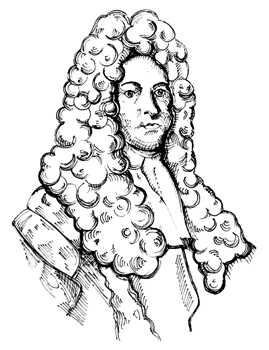 |
 |
|||
|
|
Constantine was the third son of Francis Phipps, esq., of Reading in Berkshire. He was educated at the free school in Reading and was elected to a scholarship at St. John's College, Oxford, in June 1672, but requested that the election might be postponed. He adopted the profession of law, was admitted to Gray's Inn, on 11th February 1678, and was called to the bar in 1684. He became bencher in 1706. He rose rapidly in his profession, but his Jacobite sympathies rendered promotion slow. His practice, however, was considerable, especially among the friends of the exiled house of Stuart. He acted as counsel for Lord Preston in 1691, and was associated with Sir Francis Pemberton in conducting the defence of Sir John Fenwick (1645-1697) in 1696. He assisted Sir Thomas Powys in the defence of Thomas Watson, Bishop of St. David's, deprived in 1702 for simony. But it was his management of the defence of Dr. Henry Sacheverell in 1710, which chiefly devolved upon him, that attracted public attention to him and marked him out for preferment, on the accession of the tories to power. On 12th December 1710, Constantine was knighted by Queen Anne and kissed hands as Lord Chancellor of Ireland, in the place of Richard Freeman, deceased. A month later, he arrived in Dublin and, on 22nd January 1711, was sworn one of the lords justices of the kingdom in the absence of the Lord Lieutenant, the Duke of Ormonde. His appointment was naturally distasteful to the whig party and their animosity towards him was intensified when he began, openly, to exert his influence to restore the balance of power into the hands of the tories. In July, Ormonde met Parliament. The session proved a stormy one and the Lord Lieutenant, having prorogued it with a view to a dissolution, returned to England in December, leaving the Government to Phipps and Richard Ingoldsby. The first and indispensable step to procure a more tractable parliament was to secure tory sheriffs in the counties and tory mayors in the towns. Phipps undertook the task with alacrity, but without much success. The city of Dublin led the opposition and elected a whig mayor, whom the Government refused to recognise. The catholic populous were for the castle; the well-to-do citizens and freemen were for the corporation. Both sides were obstinate and, for nearly two years, Dublin was without a municipal government. Other circumstances added to Phipps's unpopularity. During the struggle, a row occurred in the theatre. The culprit was a certain Dudley Moore, who was arraigned before the Queen's bench. The case was still under consideration when Phipps proceeded to lecture the mayor and corporation on the disturbed state of the metropolis, alluding especially to Moore's case. He was probably guiltless of any intention to prejudice the jurors against Moore, but his intervention was viewed in that light by his opponents, and led to a fierce pamphlet warfare. The publication of the 'Memoirs of the Chevalier de St. George' added fresh fuel to the fire. Edward Lloyd, the publisher, probably looked upon it as a mere business speculation, but it was natural that it should be regarded as piece of a sinister plan on the part of Government to promote the interests of the Pretender. The unfortunate publisher was at once prosecuted for libel and would, no doubt, have been punished severely had not Phipps interposed with a nolle prosequi. His conduct in this matter, added to his attempt to discourage the usual ceremony of dressing King William's statue on 4th November, rendered him extremely unpopular in the city. At the general election in the Autumn of 1713, he worked energetically to secure a tory majority in Parliament. Curiously enough, he was sanguine of success, but his expectations were doomed to disappointment; for the whigs, having obtained an overwhelming majority, at once proceeded to denounce and even to threaten him with impeachment. They voted that he had been the principal cause of the disorders and divisions of the realm, that he was working in secret to promote the interests of the Pretender and concluded by petitioning the Queen to remove him from office. His friends in the House of Lords and in convocation, however, rallied to his support and, before long, a counter address was on its way to the Queen, eulogising him as a discerning and vigilant officer, a true lover of the church and a zealous assertor of the prerogative. The death of the Queen, on 1st August 1714, and the dissolution of Parliament solved the situation. Phipps was removed from office on 30th September; and, returning to England, he at once resumed his practice at the bar. His exertions on behalf of the high-church party did not pass altogether unrecognised and, on 20th October, the University of Oxford conferred on him the degree of D.C.L. Except for his defence of the Earl of Wintoun in 1710, when he was severely reprimanded by the Lord High Steward for beginning to speak without permission, and his defence of Bishop Francis Atterbury in 1725, the rest of his life was uneventful. He died in the Middle Temple, on 9th October 1723, and was buried in St. Mary's Church in White Waltham (Berkshire). Phipps married, on 10th October 1684, Catherine Sawyer of St. Catherine Cree Church, London. He had one son, William, who married, in 1718, Catherine Annesley the only daughter and heiress of James, the 3rd Earl of Anglesey, whose son Constantine - raised to the peerage as Baron Mulgrave of New Ross, County Wexford - was ancestor of the Marquises of Normanby. Sir William Phipps, Governor of Massachusetts and inventor of the diving-bell, was a cousin of Sir Constantine Phipps. Edited from Sidney Lee's 'Dictionary of National Biography' (1896).
|
|||
| © Nash Ford Publishing 2001. All Rights Reserved. | ||||



 Sir
Constantine Phipps (1656-1723)
Sir
Constantine Phipps (1656-1723)